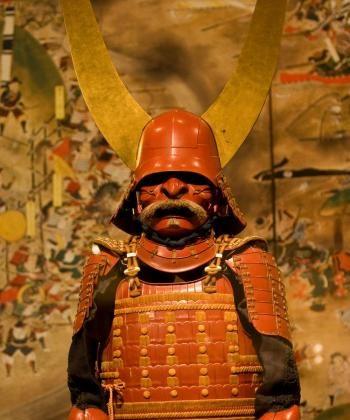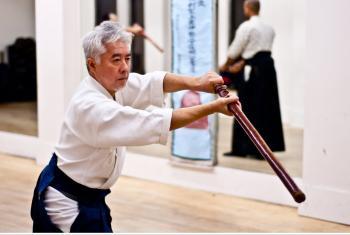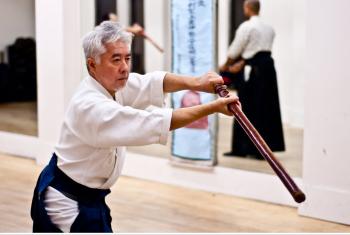NEW YORK—Masami Shioda, 60, holds a large bamboo stick wrapped in leather, facing Vernon Church, a 48-year-old Internet executive wielding a similar bamboo stick. Clack! Bang! The floor shakes with each hit, as they lunge and stomp.
Grunts, bangs, broken Japanese-English. It is like something out of an old Kung-Fu film. A moment of calm comes after each run through of a set of moves, and as they spar again—Pound! Bang!
The Shinkageryu Hyoho traditional Japanese swordsmanship classes in Manhattan have a mission to preserve the ancient culture of the samurai. The art was founded in Japan’s Warring States period that lasted from 1480 to 1570 and has been preserved nearly intact, according to Shioda.
“You could almost say there is no difference in terms of how we practice now as opposed to back in the samurai ages,”says Shioda the sensei of his NYC classes. “That’s why you can also say it’s not as popular as Kendo.”
Quick to smile and laugh, with gentle eyes and a humble demeanor, few would guess the samurai skills this man possesses. He teaches class in a rented room in a dance studio. Classical music from a dance lesson in the next room can be heard lightly through the walls. It seems to be drowned out by the clacking of their sticks, their stomping—a lively scene, indeed.
An old culture
Since the tradition of the art forbids anyone to charge money for lessons—with the exception of the Grand Master of the art—Shioda runs his classes out of various rented studios. He and his students share the rental cost. “He does it because he loves it,” says Church, one of the senior students.
After smashing at each other’s training swords they swing and stop just inches short of a neck or wrist. It looks like it could hurt. After doing a round with a student, Shioda pauses to correct his student’s movement. “Like this,” he says, teaching Vernon Church the proper way to swipe at his foot.
Shioda has practiced Shinkageryu for more than 20 years. He grew up in Kamakura, 60 miles from Tokyo. “It wasn’t practiced in my town,” he says with one of his students translating from Japanese.
“I wasn’t satisfied with Kendo,” he says, referring to his former practice. “The name Shinkageryu is very famous but I didn’t think it was alive in this modern age. Even in Japan, the number of people who practice Shinkageryu is maybe 500 people.”
Outside, it is just another rainy day in New York City. The second-floor studio could be anywhere in the world—a timeless art that keeps everything from the traditional dress to the methods of training.
“We just love the way of thinking back then,” says Shioda.
Shioda adds that part of the mission of Shinkageryu is the preservation of the samurai culture. “What’s important is preserving the essence,” he says. “All those things that could have only risen in those warring ages, and making it something that can pass down, that’s the essence that we’re trying to preserve.
“For me there’s something very unique about an art that uses the Japanese sword as opposed to empty hands,” he says. “I don’t want to put it into cheap words like ’samurai spirit,' but I feel that there’s something very Japanese, very unique in an art that uses solely Japanese sword.”
Cultivating peace
Despite the quick moves and the loud clashing of the wrapped bamboo Yagyu Shinkageryu Fukuro Shinai swords, the art is actually rather peaceful.
The founder of Aikido, O-Sensei Morihei Ueshiba, once said, “The way of the warrior has been misunderstood. It is not a means to kill and destroy others. Those who seek to compete and better one another are making a terrible mistake.”
The small Japanese man, who gained world renown when he was in his 80s continued “The real way of a warrior is to prevent such slaughter.”
Shioda shares a similar philosophy on his art. He says that through the practice, he and his students “glean the importance of life.”
There are many misconceptions of the martial arts, explains Shioda. He says often people come to him wanting to fight, or even challenge him. He laughed as he recalled once when a fencing sword fighter challenged him to a match when he was young, and Shioda accepted. He said the match was “50-50. I lost a little bit because he kept stabbing my toe.” Shioda laughs as he imitates a stabbing motion at a student’s feet.
“Very hard to block,” he adds.
A large portion of the techniques are based in teaching self-control and using less force to achieve a greater result. Shioda adds that he wants his students to understand “that you don’t need speed, you don’t need strength. Just physics and dynamics is all you need and you have the potential to reach the greatness of the founder.”
“It’s not about muscle and speed. It’s technique,” he says. “That’s what makes it so interesting.”
He adds that in teaching the philosophy and principles of the art, he wants his students to “enjoy first, and then if that sort of knowledge makes it more enjoyable, then so be it.”










Friends Read Free